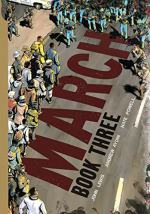|
This section contains 559 words (approx. 2 pages at 400 words per page) |

|
March: Book Three Summary & Study Guide Description
March: Book Three Summary & Study Guide includes comprehensive information and analysis to help you understand the book. This study guide contains the following sections:
This detailed literature summary also contains Topics for Discussion on March: Book Three by Andrew Aydin, John Lewis, and Nate Powell.
The following version of this book was used to create this study guide: Lewis, John; Aydin, Andrew. March, Book One; Top Shelf Productions, Marietta, Georgia, 2015. Kindle AZW file.
John Lewis is a major force in the Civil Rights Movement of the 1960s, working closely with other notable historic figures such as Dr. Martin Luther King, Jr., John F. Kennedy, and Robert Kennedy. Lewis presents his biography as a graphic novel. He is a congressman by the time Barack Obama is sworn in as America's first black president. Obama's first inauguration is the backdrop for the story of the Civil Rights Movement during the 1960s, told from Lewis's perspective. The book is the third of a three-part series but can be read as a stand-alone book.
The book opens with scenes from a church bombing in Mississippi. The bombing is a protest against the blacks who are calling for equal rights, including the right to vote without fear of reprisal. On the day of the bombing, the church is hosting a youth rally and four little girls are killed in the blast. That event is just one of many violent attacks that happen in the South over the mid-1960s.
As black leaders focus on the right to vote, volunteers join the effort. There are some black leaders who believe bringing white volunteers into the mix is a bad idea, but others believe that a massive influx of volunteers – both white and black – is the logical next step. That train of thought wins out and hundreds arrive in specified regions. Almost immediately, three volunteers fail to arrive at their assigned location. The media and federal government reach heightened levels of interest as the public becomes aware that two of the three missing men are white. The government sends military and FBI agents to search for the men, and their bodies are found weeks later.
Meanwhile, officials decline to provide protection for black protestors. Even while federal officials are searching for the missing volunteers, they do not offer to curb the violence against those insisting on equality for blacks.
Blacks are routinely beaten and intimidated as they continue to protest. Few are swayed by the violence, and most continue to work toward the cause regardless of the threats. Lewis is beaten and hospitalized, and others face similar situations. A woman named Fannie Hamer registers to vote but her family is evicted from their home and the landowner they work for fires them. She is even attacked, which leaves her with a permanent limp. Hamer never stops speaking out, and she is among those who talk at the Democratic Party Convention as blacks seek equal representation for seats on the delegation and candidates. With each new attack, more volunteers arrive. Various groups join the protests, including teachers.
The political and social climates impact the protestors and the individual members. With the death of President John F. Kennedy, many worry whether his successor – President Johnson – will follow through with Civil Rights reforms.
As the movement advances, there are rifts among the protestors and organizations face the challenges of operating on limited budgets while bringing people together for common goals. Sometime, leaders clash as their different ideas and policies are put into play. Ultimately, Lewis and others continue to work, each in his own way, leading like-minded people who are seeking change.
Read more from the Study Guide
|
This section contains 559 words (approx. 2 pages at 400 words per page) |

|



